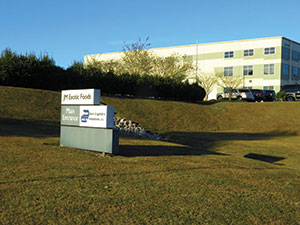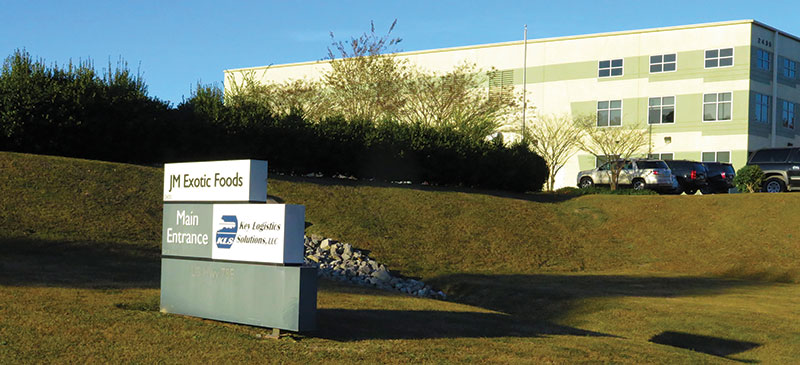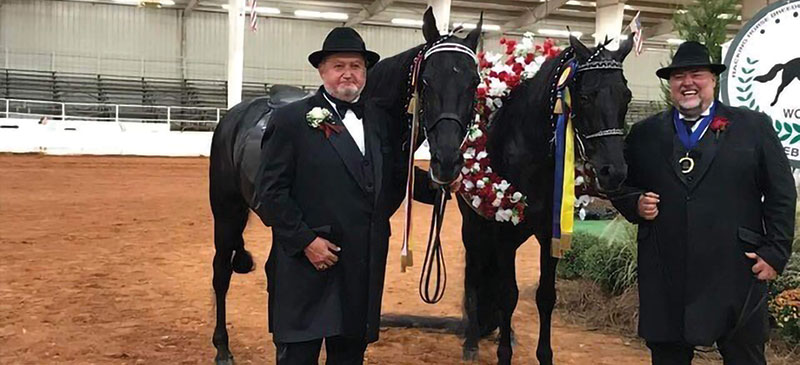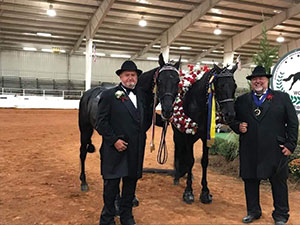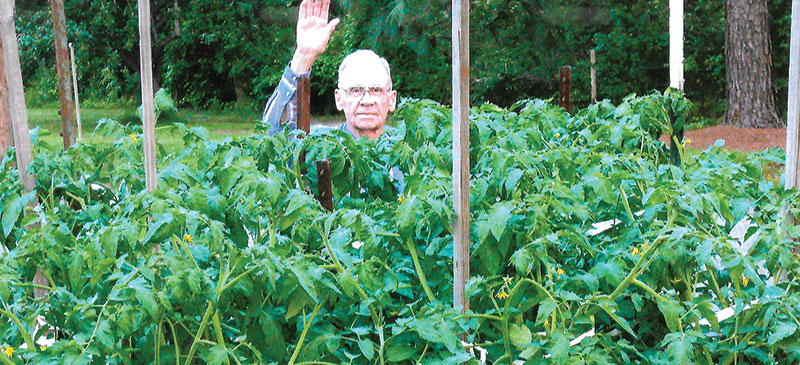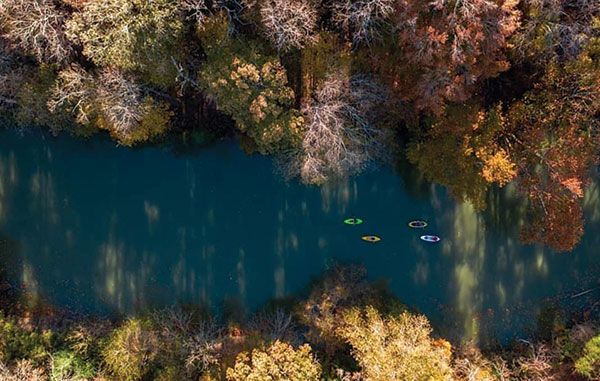Historian, storyteller, family man, friend
Story by Joe Whitten
Photos by Wallace Bromberg Jr.
Submitted Photos
This month’s travels along St Clair County backroads brings us to
the Bethel community to stop at the home of retired Moody businessmen and local
historian, Carl Coupland.
Born into a hardworking family on Jan. 16, 1932, Carl grew up with
a work ethic that helped him succeed in his endeavors. He comprehended
economics early-on. “I tried raising beef cattle on a small scale,” he said,
“but it didn’t take long for me to get out of that, because you could go to
your local supermarket and buy a bag of dried cow manure for your flower bed or
garden plants for $0.20 per pound, but live cattle was selling for $0.18 per
pound. The economy was all out of balance when the manure was worth more than
the cow!”
Coupland family roots in St. Clair County go back prior to 1828,
the year Carl’s great grandfather, Columbus Constantine “C.C.” Coupland, was
born near Cook Springs. C.C. married Elizabeth Emaline Godwin in 1848, and they
set up housekeeping in a home he had built in the Bethel community. Around
1856, on today’s Coupland Road, he built another home which served Couplands
for generations. Carl’s granddad, Ira, was born in the house.
Carl enjoys telling how his parents met. “My mother, Mary
Elizabeth Sheets, was born where Oak Mountain Park is located. Then she moved
with her parents to land they owned where Greystone subdivision is today.
“Daddy, Lester Coupland, was down there doing rock work on Bold
Springs Church and boarding with the Standifer family. He went to a Pie Supper
at the church, where folk would bid on pies the girls brought. He saw that
pretty girl there, and he bid on her pie – up to $5!”
They were married March of 1929 at Rev. Hurst’s home in
Taylorsberg, Alabama, near today’s Kerr Road.
Lester and Mary Elizabeth set up housekeeping in a house on
Coupland land where today’s Lazy V lakes are, but there were no lakes then. Two
sons were born into the family, Joe (1930) and Carl (1932).
Lester plowed with a mule
farmland which was terraced to prevent erosion. Carl’s earliest memory there
occurred shortly before he turned four. “I was in the yard, and my Dad said,
‘We’re gonna move way over there across that mountain.’ We could see Bald Rock
Mountain. …I was three years and eight months old when we moved to Camp
Winnataska.”
Lester worked as stone mason and caretaker at Camp Winnataska,
owned by the Birmingham Sunday School Council. The Council provided the
Couplands a rent-free home. It had a fireplace and a kitchen sink, and it made
no difference to them that the house had no electricity, no running water,
bathroom facilities or telephone, for they were accustomed to that. Lester’s
salary of $35 per month had increased to $70 a month in 1940 when he moved the
family back to the farm.
Carl and Joe explored every acre of the camp while living there.
They attended school one year at Stewart’s Crossroads near Prescott and then
rode the bus to Moody School two years.
Carl’s memories of Camp Winnataska and Lester’s stone masonry are
in Discover, June-July 2012, and can be read at this link: bit.ly/2ryrTXu
On the farm, Joe and Carl plowed with mules, helping their Dad
with the farming. In 1942, Lester took a job with the Coca-Cola Co. in Leeds,
driving a delivery truck in Jefferson and St. Clair counties. After that, he
drove a gasoline truck for J.W. McCraney Co. in Leeds.
In 1945, Lester bought the old C.C. Coupland home on Coupland
Road. Carl’s mom and her friend Mable Moore wallpapered the house and got it
move-in ready. This was their first home to have a bathroom.
Carl recalls moving day. “Daddy went off to work one morning, and
Mother said, ‘Let’s move.’ I was 13 years old and Joe was 15. We hooked up the
two mules, Old Jane and Old Kate, and drove that wagon and started moving our
stuff. We moved all the furniture that day.”
There were two girls in the community, Carolyn Moore and Nelda
June Taylor, who helped them move, and were a great help to Mrs. Coupland. She
was used to boys’ help and enjoyed having girl-help that day.
Driving home from work, Lester saw smoke curling from the chimney,
stopped and discovered a tidy home and supper simmering on the wood cook-stove.
Carl finishes the story. “The man Daddy drove the truck for also
had a tobacco and confectionery company, and Daddy had brought home a box of
Hershey’s candy. Now, chocolates were hard to come by during WWII. I don’t
remember whether it was 12 or 24 bars, but those girls ate up our box of candy
the day we moved.”
Carl chuckled and said, “The little 13-year-old Nelda June Taylor
became my wife nine years later on 3 December 1954. As of now, I have been lucky
enough to live with the best woman on earth for more than 65 years.”
Joe and Carl attended Branchville School through the sixth grade
and then attended Odenville school. Joe graduated from St. Clair County High
School in 1948, attended college and eventually earned a PhD from Ohio State.
Dr. Coupland served as principal of Phillips High School in Birmingham and of
Morgan County High School in Hartselle. He was director of Adult Education with
the Birmingham City Board of Education when he retired. Shortly after
retirement, he died of pancreatic cancer in June 1985. He was the first PhD
elected to the St. Clair County Board of Education, of which he was chairman
when he died.
A desire to serve
Carl’s interests took him in a different but productive direction.
Six months’ shy of graduating high school, he joined the Air Force. Signing up
before his eighteenth birthday, he couldn’t leave then because his parents
wouldn’t sign for him. But, on his birthday, Jan. 17, 1950, he boarded
Odenville’s Mize Bus to Birmingham and took the train for Lackland Air Force
Base, San Antonio, Texas, for basic training.
As he tells it, “I was young and knew everything at 18 years old.
My parents didn’t know anything, and I had the world by the tail with a
down-hill pull!”
After Lackland, Carl went to Radio Operator School at Keesler Air
Force Base, Biloxi, Miss. The Korean War broke out in June 1950, so after
finishing at Keesler in October, Carl and others were sent to Mitchell Air
Force Base, Long Island, New York, for reassignment.
Carl’s family feared he was destined for Korea, but instead he
landed at Ft. Meade, Md., in Aircraft Control and Warning. One day the
commanding officer asked for three volunteers to go to work in Flight Safety at
Air Defense Command Headquarters in Colorado Springs. Carl volunteered.
Given a week’s furlough and having heard his buddies tell about
hitchhiking, he decided to hitchhike home. He took a bus from Ft. Meade to
Winchester, Va., then got on U.S. 11, put out his thumb, and the first car, a
new 1950 Chevrolet, stopped.
Carl thought he recognized the driver’s voice but couldn’t place
it. When they introduced themselves, it was Bert Parks, who had the famous New
York radio program, Stop the Music. He was going to Rome, Ga., for a
show and had to side-track to Columbia, S.C., to get two showgirls, and Carl
went with him.
Parks thanked Carl for his service and paid for all the meals on
the trip. “Wouldn’t let me spend anything on the way down,” Carl recalled.
Arriving in Rome at 2 o’clock on a cold, pitch-black December
morning, Carl got back on the highway to catch a ride. No headlights lit the
blackness all night. “Just after daybreak,” Carl said, “I saw a Greyhound bus
coming that had ‘Birmingham’ written on it. I flagged him down and rode the bus
to Springville.”
Carl paid $2 to a Springville taxi driver to take him to his
parents’ home. He visited five or six days, then caught a bus back to Fort
Meade, and from there, the volunteers took a train to Colorado Springs.
The train trip took two days with a four-hour lay-over in Chicago
where the USO Club fed the volunteers and gave each one a Bible. The men left
the train in Denver and took a bus 70 miles further to Colorado Springs.
The Air Defense Command had just been started, and to be in the
center of the country had moved to a Colorado Springs Army Base and was redoing
it. Headquarters were completed and in use, but the barracks weren’t finished.
So, for about four months, the men lived in a hotel in Manitou Springs.
Carl bought a 1936 Chevrolet for $35. He and two of his buddies drove it to and
from the base until they completed the barracks.
Because Carl was a clerk and a radio operator, he was assigned to
work with officer pilots who had to fly four hours a month in order to keep
their flying status – their wings.
The United States had Aircraft Control and Warning squadrons as
well as Fighter Squadrons stationed around the country.
Carl, promoted to the flight safety crew, tracked the locations on
a large map above his desk. On it, blue pins showed the location of every
Fighter Interceptor Squadron, and red ones of every Aircraft Control and
Warning Squadron.
For this work, Carl knew secret information and had to have top
secret clearance. The FBI investigated him, sending agents to Odenville and
Branchville to talk with neighbors, friends, preachers and teachers.
“My parents thought this boy was in trouble,” Carl laughs, “but I
wasn’t. After that, whenever we had an accident involving one of our
interceptor planes, we flew to investigate the scene.”
Carl’s crew collected wreckage. If fatalities had occurred,
casualty remains had been cleared by an earlier crew. However, as he worked one
site, the sun glinted off something. “I think that was roughest scene I ever
went to,” Carl said. “Two F-86 Sabres flew out of the fog and right into the
side of a mountain. There wasn’t much left.
“We collected wreckage parts and pieces and got ‘em piled up. I
saw something shining on the ground. It was a man’s hand with a gold ring on
it. I picked up the hand and gave it to
the commanding officer. He was to get the ring to the widow. I trusted him to
do that.”
Such memories linger, and Carl reflects, “You know, I have
sometimes thought about that hand at 12 o’clock at night.”
Carl and his buddies used free weekends exploring Colorado –
Pike’s Peak, Will Rogers Shrine, Garden of the Gods, Seven Falls and parks.
They made one Juarez, Mexico, excursion with Carl protesting it might not be a
wise trip. Carl drove his car, and one buddy rode his motorcycle. At the
border, Carl parked his car at a gas station and paid the attendant to watch
it. His buddy chained the front wheel of his motorcycle to a telephone pole
away from the station.
It didn’t take a long to realize Juarez wasn’t where they should
be, and they returned to where they’d parked. “My car was fine,” Carl laughed,
“but all that was left of the motorcycle was the front wheel chained to the
pole.”
An interesting follow-up to Carl’s Air Force years is that his
cousin, Adm. James A. Winnefeld, Jr., who had been an instructor in the Navy
Top Gun School and had done the flying in the movie Top Gun, became the
officer in charge of Carl’s old outfit in Colorado Springs. Adm. James A.
Winnefeld’s mother, Fredda Coupland, was born in St Clair County. She married
career Navy man, James A.Winnefeld Sr., later an admiral himself.
In President Obama’s administration, Adm. James Winnefeld Jr.,
became vice chairman of the Joint Chiefs of Staff. He was the second highest
ranking military person in the United States at that time, serving under Gen.
Martin Dempsey, chairman.
While Carl served in the Air Force, Nelda June Taylor earned her
nursing degree. She had worked her way through three years training at the
Jefferson Hillman Hospital in Birmingham, when the University of Alabama bought
Hillman Hospital, and it became UAB Hospital. June’s graduation ceremonies were
at the University of Alabama in Tuscaloosa.
Carl and June married Dec. 3, 1954. As a registered nurse, June
worked at ACIPCO Medical Group and at Dr. Davis’ Clinic in Leeds.
Before settling full-time as a realtor, Carl worked at different
jobs. Gulf Oil Co. put him at a station on Highland Ave and 20th
Street, with gas islands all the way around the corner.
He had the 11-to-7 shift and was by himself from 1 a.m. to 5 a.m.
“I had a money changer on my belt, a roll of money in my pocket, and was there
by myself pumping gas at night. I felt safe back then,” he recalls.
Then he opened a service station in Branchville, at the location
of the car lot today on the corner of Hurst Road and U.S. 411. He and June
bought a house and nine acres across the road from the station.
Their son, Mike, was born there in 1957, and they lived there
until 1968 when they moved to the property where their home is today.
Eventually, he divided the Branchville acreage into lots for a subdivision
there.
For a while, he had an insurance debit route from Cahaba Heights
to Sylacauga. Realizing that wasn’t for him, he took a job with Leeds
businessman, Judge McCraney, who owned McCraney Tobacco and Confectionary Co.
Asked about his real estate work, Carl said, “I started buying
land and farms in 1955, while I was working other jobs. I did this until 1968
when I got my real estate broker’s license and opened an office in Leeds across
from the Pants Store.”
While Carl was building his real estate business, Mike graduated
from high school and married Jeanie Kerr. They became parents to twin
daughters. Carl said of his daughter-in-law, “She is the nicest person you
could have ever imagined in your life.”
Mike became a union carpenter and had worked his way to a
superintendent’s position. Advancement sometimes brings relocation, and in
1985, the company wanted Mike to move to Florida. However, he told his father,
“I really don’t want to go.” Carl said, “Come into the real estate business
with me, and we’ll see how you do.” Mike runs the business today.
Carl stayed in Leeds until 1985, then moved to Moody and opened
Moody Realty. He and Mike together ran Moody Realty Co. until Carl retired at
age 84 in 2016.
Recalling his work, Carl said, “My business was great. People were
coming out of Birmingham and moving to Leeds, Moody and Odenville. I remember
selling five houses in one day.”
Catherine Lovejoy worked in the gas company in Leeds next door to
Carl’s office, and the Lovejoys and Carl became friends. “Lyman (Lovejoy) was
selling real estate part time and holding down a full-time job,” Carl said.
“He came in my office one day and asked me, ‘Do you think if I got
into the real estate business full time that I could make it?’ I said, ‘Lyman,
the time is right. People are moving out of Birmingham. Get you six months’
grocery money ahead and jump into it.’
“He didn’t take my advice. He got a year’s grocery money ahead and
jumped in. Well, it wasn’t long until he had enough business that Catherine had
to quit work and help him. … Lyman was always honest with me. We trusted each
other. He just had more nerve than I did. I made a living, and he made a
fortune.”
Some land sales Carl remembers with pride, and rightly so. Leeds
Memorial Park is enjoyed today on land he sold to the city through Mayor Jack
Courson. Carl worked with the St. Clair County Board of Education to obtain
land for the Moody High School, Junior High School and Middle School – and land
for a second road into the school property. Shortly before he retired, he
worked with Moody’s Mayor Joe Lee for the Jack’s Family Restaurant site to be
located on Moody Parkway. And we all know that the problems of the world have
been solved over breakfast at a Jack’s round table, Anywhere, USA.
Of his son and Moody
Realty, Carl says with pride, “Mike has done well with the business. Paula
Krafft is his right arm, and Allie, her daughter-in-law, works in the office.
Paula and Allie are the most knowledgeable real estate people I have ever
known. Mike could go off fishing three days, and they could run the place.”
On occasion, a real estate person has not been above-board and
honest with Carl, but he never retaliated. He quietly wrote the person’s name
on a piece of paper, dropped it in his bottom desk drawer, and never did
business with them again.
Today, June and Carl are doting grandparents and
great-grandparents to Beverly and husband Alex Armstrong with their daughters,
Allee June and Caroline, and to Ginger and husband, Jeremy Gilbert, with their
children, Jackson Cade, Kinslee Morgan and Ellison Kate.
This younger generation is growing up hearing Carl’s memories of
the past. But in case he doesn’t share this Halloween tale, we record it here.
One fateful Oct. 31, many years ago, Carl and three friends had
the prankish idea to put a cow in their ball coach’s house while he and his
wife were at a party. This they did and skedaddled – home free, they thought.
However, when Mrs. Coach found a cow in her living room, she exclaimed, “Carl
Coupland and (name withheld to respect the dead) did this!’ She guessed two
correctly, but Mrs. Coach never told the pranksters’ parents. She had boys of
her own.
Should you have an hour or two to visit him, Carl can tell you St.
Clair County history that he learned from listening to his father and
grandfather tell of their lives and from reading anything he can get his hands
on.
Carl
Coupland: father, grandfather, businessman, historian and conversationalist.
Listen to him. He’s a St. Clair County icon worth knowing and hearing.

